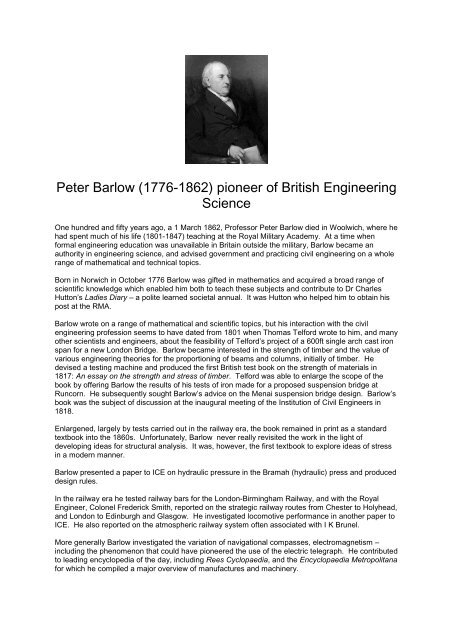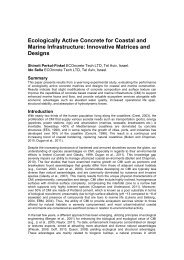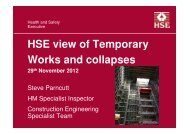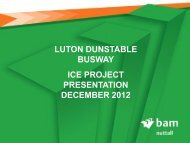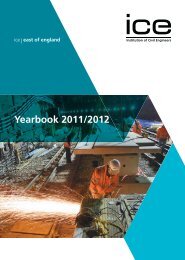Peter Barlow (1776-1862) - Institution of Civil Engineers
Peter Barlow (1776-1862) - Institution of Civil Engineers
Peter Barlow (1776-1862) - Institution of Civil Engineers
Create successful ePaper yourself
Turn your PDF publications into a flip-book with our unique Google optimized e-Paper software.
<strong>Peter</strong> <strong>Barlow</strong> (<strong>1776</strong>-<strong>1862</strong>) pioneer <strong>of</strong> British Engineering<br />
Science<br />
One hundred and fifty years ago, a 1 March <strong>1862</strong>, Pr<strong>of</strong>essor <strong>Peter</strong> <strong>Barlow</strong> died in Woolwich, where he<br />
had spent much <strong>of</strong> his life (1801-1847) teaching at the Royal Military Academy. At a time when<br />
formal engineering education was unavailable in Britain outside the military, <strong>Barlow</strong> became an<br />
authority in engineering science, and advised government and practicing civil engineering on a whole<br />
range <strong>of</strong> mathematical and technical topics.<br />
Born in Norwich in October <strong>1776</strong> <strong>Barlow</strong> was gifted in mathematics and acquired a broad range <strong>of</strong><br />
scientific knowledge which enabled him both to teach these subjects and contribute to Dr Charles<br />
Hutton’s Ladies Diary – a polite learned societal annual. It was Hutton who helped him to obtain his<br />
post at the RMA.<br />
<strong>Barlow</strong> wrote on a range <strong>of</strong> mathematical and scientific topics, but his interaction with the civil<br />
engineering pr<strong>of</strong>ession seems to have dated from 1801 when Thomas Telford wrote to him, and many<br />
other scientists and engineers, about the feasibility <strong>of</strong> Telford’s project <strong>of</strong> a 600ft single arch cast iron<br />
span for a new London Bridge. <strong>Barlow</strong> became interested in the strength <strong>of</strong> timber and the value <strong>of</strong><br />
various engineering theories for the proportioning <strong>of</strong> beams and columns, initially <strong>of</strong> timber. He<br />
devised a testing machine and produced the first British test book on the strength <strong>of</strong> materials in<br />
1817: An essay on the strength and stress <strong>of</strong> timber. Telford was able to enlarge the scope <strong>of</strong> the<br />
book by <strong>of</strong>fering <strong>Barlow</strong> the results <strong>of</strong> his tests <strong>of</strong> iron made for a proposed suspension bridge at<br />
Runcorn. He subsequently sought <strong>Barlow</strong>’s advice on the Menai suspension bridge design. <strong>Barlow</strong>’s<br />
book was the subject <strong>of</strong> discussion at the inaugural meeting <strong>of</strong> the <strong>Institution</strong> <strong>of</strong> <strong>Civil</strong> <strong>Engineers</strong> in<br />
1818.<br />
Enlargened, largely by tests carried out in the railway era, the book remained in print as a standard<br />
textbook into the 1860s. Unfortunately, <strong>Barlow</strong> never really revisited the work in the light <strong>of</strong><br />
developing ideas for structural analysis. It was, however, the first textbook to explore ideas <strong>of</strong> stress<br />
in a modern manner.<br />
<strong>Barlow</strong> presented a paper to ICE on hydraulic pressure in the Bramah (hydraulic) press and produced<br />
design rules.<br />
In the railway era he tested railway bars for the London-Birmingham Railway, and with the Royal<br />
Engineer, Colonel Frederick Smith, reported on the strategic railway routes from Chester to Holyhead,<br />
and London to Edinburgh and Glasgow. He investigated locomotive performance in another paper to<br />
ICE. He also reported on the atmospheric railway system <strong>of</strong>ten associated with I K Brunel.<br />
More generally <strong>Barlow</strong> investigated the variation <strong>of</strong> navigational compasses, electromagnetism –<br />
including the phenomenon that could have pioneered the use <strong>of</strong> the electric telegraph. He contributed<br />
to leading encyclopedia <strong>of</strong> the day, including Rees Cyclopaedia, and the Encyclopaedia Metropolitana<br />
for which he compiled a major overview <strong>of</strong> manufactures and machinery.
<strong>Barlow</strong>’s two sons William Henry and <strong>Peter</strong> William benefitted from the grounding in engineering<br />
science he was able to provide to become leading civil engineers. William Henry became President<br />
<strong>of</strong> the ICE and is well know for the design <strong>of</strong> the St Pancras Station train shed, one <strong>of</strong> the wonders <strong>of</strong><br />
the railway age.<br />
Exhibits<br />
1811 An elementary investigation <strong>of</strong> the theory <strong>of</strong> numbers.<br />
1814 A new mathematical and philosophical dictionary.<br />
1821 On the effects produced in the rates <strong>of</strong> chronometers by the proximity <strong>of</strong> masses <strong>of</strong><br />
iron. Philosophical transactions.<br />
1822 On the anomalous magnetic action <strong>of</strong> hot iron between the white and blood-red heat.<br />
Philosophical transactions.<br />
Publications include<br />
1808 Articles for Rees’ Cyclopaedia, <strong>of</strong> Universal Dictionary <strong>of</strong> Arts and Sciences.<br />
1809 On the motion <strong>of</strong> floating Bodies in running Water. Phil. Mag. XXXIII, 300-302<br />
1811 An Elementary Investigation <strong>of</strong> the Theory <strong>of</strong> Numbers,<br />
1814 A New Mathematical and Philosophical Dictionary.<br />
1817 Essay on the Strength and Stress <strong>of</strong> Timber and other Materials. (six editions in English<br />
between 1817 and 1867, and a French edition in 1828).<br />
1818 Calculation <strong>of</strong> the Stress and Strength <strong>of</strong> the projected Iron Hanging Bridge over the Menai<br />
Strait in Papers Relating to the building a Bridge over the Menai Strait, near Bangor Ferry. House <strong>of</strong><br />
Commons, 1819, 13-14<br />
1821 On the effects produced in the rates <strong>of</strong> Chronometers by the proximity <strong>of</strong> masses <strong>of</strong> iron. Phil.<br />
Trans., 361-390<br />
1822 On the anomalous magnetic action <strong>of</strong> hot-iron between the white and blood-red heat. Phil.<br />
Trans., 117-126<br />
1823 An Essay on Magnetic Attractions<br />
1823 Account <strong>of</strong> a new series <strong>of</strong> Electro-magnetic Experiments; with observations on the<br />
mathematical Laws <strong>of</strong> Electro-Magnetism. Edin. Phil. Journ., VIII, 368-382<br />
1823 Observations and experiments on the daily variation <strong>of</strong> the Horizontal and Dipping Needles<br />
under a reduced directive power. Phil. Trans., 326-341<br />
1824 An Account <strong>of</strong> the experiments made on board H.M’s .ships, Leven, Conway, and Griper, for<br />
correcting the local attractions <strong>of</strong> those vessels<br />
1825 ‘On the Force exerted by Hydraulic Pressure in a Bramah Press’, Edin. Journ. Sci., II, 293-<br />
296; Trans. Instn. Civ. Engrs. 1, (1836) 133-140<br />
1827 ‘Improvement <strong>of</strong> Achromatic object-glasses’, Phil. Trans., 231-267<br />
1827 Some particulars relative to the Tides in the upper part <strong>of</strong> the river Thames, and <strong>of</strong> the<br />
obstructions caused by the present (i.e., old) London Bridge. Edinb. New Phil. Journ., II, 49-59<br />
1827 On the secondary deflections produced in a magnetized needle by an iron shell, in<br />
consequence <strong>of</strong> an unequal distribution <strong>of</strong> magnetism in its two branches. First noticed by Captain J<br />
P Wilson, HEICS, “Hythe”, Phil. Trans., 276-285<br />
1828 An account <strong>of</strong> a series <strong>of</strong> experiments made with a view to the construction <strong>of</strong> an achromatic<br />
telescope with a Fluid concave Lens, instead <strong>of</strong> the usual Lens <strong>of</strong> Flint Glass. Phil. Trans., 105-112<br />
1828 Experiments relative to the effect <strong>of</strong> temperature on the refractive index and dispersive power<br />
<strong>of</strong> expansible fluids, and on the influence <strong>of</strong> these changes in a telescope with a Fluid Lens. Phil.<br />
Trans., 313-318<br />
1828 An account <strong>of</strong> the preliminary experiments and ultimate construction <strong>of</strong> a Refracting<br />
Telescope <strong>of</strong> 7.8 inches aperture, with a Fluid concave Lens. Phil. Trans., 33-46<br />
1830 On the performance <strong>of</strong> Fluid refracting Telescopes, and on the applicability <strong>of</strong> this principle <strong>of</strong><br />
construction to very large instruments. Phil. Trans. 9-16<br />
1831 On the probable electric origin <strong>of</strong> all the phenomena <strong>of</strong> terrestrial magnetism. Phil. Trans., 99-<br />
108<br />
1831 On the errors in the course <strong>of</strong> vessels, occasioned by local attraction; with some remarks on<br />
the recent loss <strong>of</strong> HMS “Thetis”. Phil. Trans., 215-222
1833 Report on the present state <strong>of</strong> our knowledge respecting the Strength <strong>of</strong> Materials. Brit.<br />
Assoc. Rep., 93-104<br />
1833 An account <strong>of</strong> the construction <strong>of</strong> a Fluid lens Refracting Telescope <strong>of</strong> 8 inches aperture and<br />
8¾ft long made for the Royal Society by George Dolland. Phil. Trans., 1-14<br />
1833 On the present situation <strong>of</strong> the magnetic lines <strong>of</strong> equal variation, and their changes on the<br />
terrestrial surface. Phil. Trans., 667-674<br />
1834 On the principle <strong>of</strong> construction and general application <strong>of</strong> the Negative Achromatic Lens to<br />
telescopes and eye-pieces <strong>of</strong> every description. Phil. Trans., 205-208<br />
1835 Experiments on the Transverse Strength and other properties <strong>of</strong> Malleable Iron, with<br />
reference to its uses for railway bars; and a Report founded on the same, addressed to the Directors<br />
<strong>of</strong> the London and Birmingham Railway Company<br />
1835 Second Report addressed to the Directors and Proprietors <strong>of</strong> the London and Birmingham<br />
Railway, founded on an inspection <strong>of</strong>, and experiments made on the Liverpool and Manchester<br />
Railway (repr. 1837)<br />
1836 Letter to the Rev. D Lardner, on the theory <strong>of</strong> gradients in railways. Phil. Mag., VIII, 97-100<br />
1836 Remarks on Lecount’s treatise on iron rails. Phil. Mag., VIII, 291-293<br />
1836 Observations on the valuation <strong>of</strong> the mechanical effect <strong>of</strong> gradients on a line <strong>of</strong> railroad. Roy.<br />
Soc. Proc. III, 390-391<br />
1837 On the Electro-magnetic conducting power <strong>of</strong> wires <strong>of</strong> different qualities and dimensions. Phil.<br />
Mag., XI, 1-11<br />
1837-38 Two reports <strong>of</strong> the Commissioners on Railways in Ireland (with others)<br />
1838 D. Mahan. Course <strong>of</strong> <strong>Civil</strong> Engineering, edited by <strong>Barlow</strong>. Repr 1848<br />
1840 T. Tredgold. Principles <strong>of</strong> Carpentry, edited by <strong>Barlow</strong><br />
1842 An investigation into the power <strong>of</strong> Locomotive Engines, and the effect produced by that power<br />
at different velocities. ICE Trans., III, 183-196<br />
1848 The Encyclopaedia <strong>of</strong> arts, manufacturers and machinery (from Encyclopaedia Metropolitana,<br />
1836, etc.


